What to Know About Switching to LED Lightbulbs
Swapping out your incandescent lightbulbs for LEDs has several benefits. These include saving money on your electric bill, superior light quality, less impact on the environment and replacing bulbs once every decade or two instead of every few months.
But shopping for LEDs can be a dizzying experience. Aside from the bevy of bulb shapes to choose from, there are terms you’ve probably heard before, such as lumens and Kelvin, but don’t exactly understand. On top of that, there’s a seemingly endless array of light types and colors, such as daylight, warm white and so on. When you just need a couple of lightbulbs to replace, it all can be overwhelming.
If you’re thinking of making the switch, here’s what you should know about LEDs and selecting the best replacements.
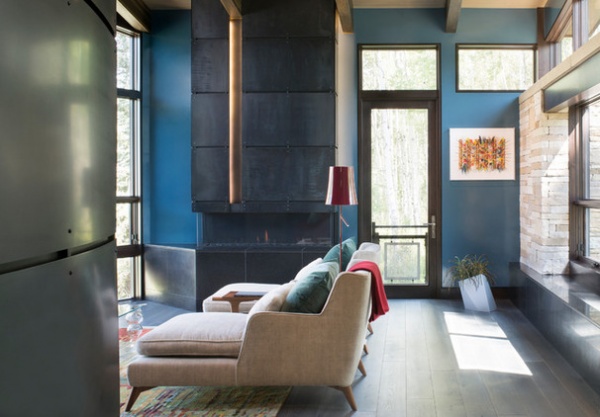
How LED Bulbs Differ From Incandescent Bulbs
Light output versus heat waste. “LED” stands for “light-emitting diode.” While we won’t get into the nitty-gritty about how they work, LEDs are vastly different from incandescent bulbs in terms of the light output compared with the heat produced. Taylor Jantz-Sell, an Energy Star lighting program manager at the U.S. Environmental Protection Agency, says that LED technology converts 95 percent of the energy to light and only 5 percent is wasted as heat.
Incandescents are pretty much the opposite. They convert only 10 percent of the energy into light, while 90 percent is wasted as heat. Heat produced by LED lights is absorbed into an integral “heat sink,” which prevents the bulb from overheating. Incandescents just throw all that excess heat directly into the room, which can place added stress on air conditioning systems during the summer.
Flexibility in light direction. Light produced by an LED is directional or focused, whereas incandescent bulbs throw light in all directions. Directional light makes the LED more efficient because the light can be focused for specific applications. LED light strips are a commonly used type, as seen in the photo above, in which LEDs illuminate the recessed reveal on a fireplace designed by Gregg Mackell of 186 Lighting Design Group. In addition, the light produced by the fixture doesn’t get lost or wasted inside of the light fixture housing, as it does with many omnidirectional incandescents and even CFLs (compact fluorescent lamps).
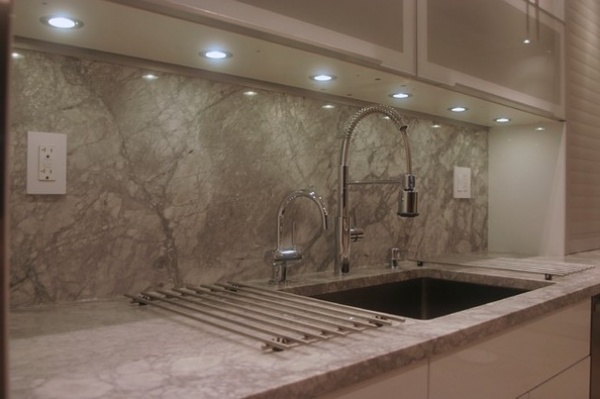
LED Ratings
As with anything else you buy, don’t expect all LED lightbulbs to be of the same quality. An easy way to figure out which ones are higher quality and meet certain standards is to look for the Energy Star label.
Energy Star is a voluntary program established by the EPA to help consumers save money and protect the environment by identifying products that have excellent energy efficiency.
You’ve probably seen an Energy Star sticker on appliances or other products you’ve purchased. Well, LED lightbulbs and fixtures are also labeled after being put through rigorous testing and certified by independent third parties. Only LED bulbs that meet certain standards, which will be reviewed below, receive the rating. So, selecting products without the rating means you run the risk of ending up with lower-quality bulbs or fixtures.
While gravitating toward Energy Star-labeled bulbs is an easy thing to do on a consumer level, Mackell says it’s not the deciding factor for what he uses in his firm’s lighting designs. He points out that it takes time for something to go through the testing process, and because LED technology is moving so fast, the next generation of LEDs is probably shipping from factories while older technologies are still being assessed and rated. So it’s always best to do a little research first and, if possible, consult a lighting designer or knowledgeable employee at your hardware store.
Find a lighting pro now
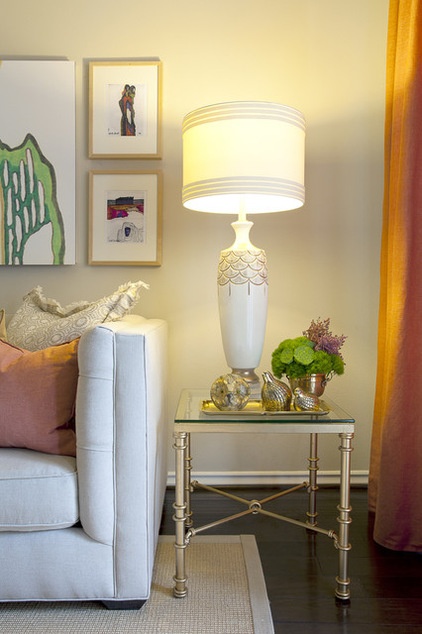
Replacing Your Old Bulbs With LEDs
Many folks don’t need specialized strip lighting but need to replace standard screw-base bulbs in ordinary table lamps. Jantz-Sell says that Energy Star verifies that the LED replacement bulb matches the performance of the bulb it is meant to replace.
“So an Energy Star-certified LED bulb labeled A19 (the A-bulb equivalent) must be omnidirectional like the bulb it is supposed to replace,” she says. “A labeled PAR38, common for outdoor security lights, must direct light the same way with the same beam intensity as a halogen PAR38. The same goes for an MR16, a common small-diameter spotlight.”
LEDs are flexible in that they can be used in specific, focused areas as well as for multidirectional ambient lighting.
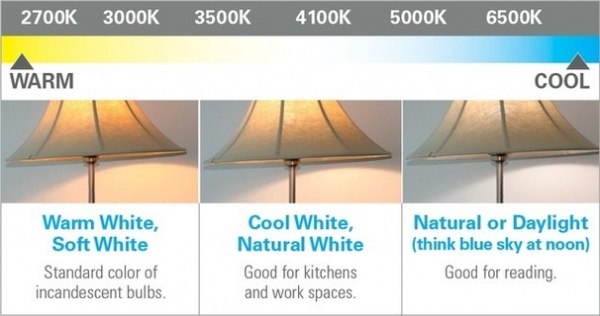
Light Color and Temperature
You’ve likely heard or noticed that the old status quo incandescent lightbulb casts a yellowish light. This incandescent yellow glow is also referred to as “warm white” or “soft white.” While it’s what most of us grew up with, when compared to cooler light colors, incandescent light can appear dingy. What might be surprising is that cooler tones of light are actually more natural, as daylight is cool and bright. This image shows the differences between the different light colors in the same room setting.
But to understand light color, you need to first understand a couple of terms. The Correlated Color Temperature, or CCT, is the color of light emitted by a bulb in terms of a “light appearance number” that correlates to a Kelvin (K) temperature scale. As you can see on the image, the lower the Kelvin number, the yellower the light; the higher the number, the bluer the light.
Standard incandescents are around 2,700K, while 4,100K is a crisp, whiter light, and 5,000K represents daylight. Unlike incandescents, LEDs are available in a number of Kelvin options to fit a variety of homeowners’ lighting needs. Bulb manufacturers must provide this number on the lighting facts label on the packaging.
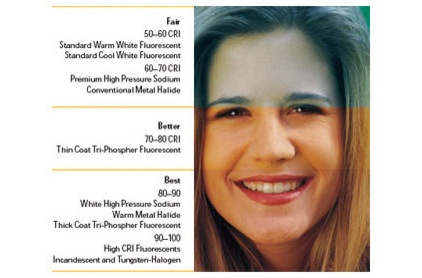
The Color Rendering Index, or CRI, is a measurement of how accurately a light source shows color. Unlike the CCT, the CRI is not about whether the light is physically bluer or yellower, but how authentic the colors appear. They’re two concepts that seem related but are actually different.
The CRI is rated on a numerical scale from 0 to 100, 0 being poor and 100 being perfect color accuracy. A CRI rating of 80 and above is considered the best category; as you can see here, the woman’s skin tones look natural in the CRI range of 80 to 100.
Some but not all LED bulb manufacturers list the CRI rating on the packaging. However, Energy Star does not certify any LED bulb with a CRI rating of less than 80, so if you’re buying a bulb with an Energy Star logo on it, you know it has a high color-rendering quality.
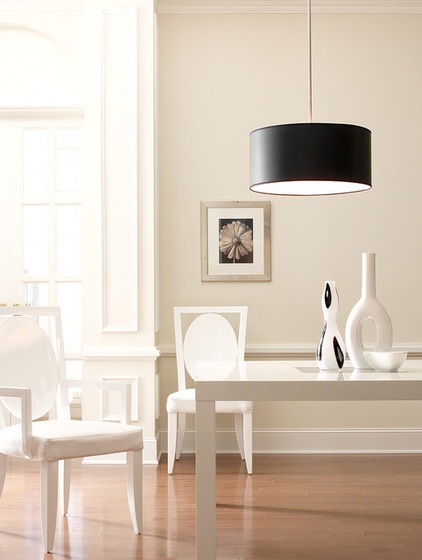
What to Use and Where
While light color choice is a personal preference, “cool white” and “natural white” are good choices for general ambient light as well as for spaces that require more focused work, like kitchens and desk areas. So you can use these light colors in most areas of your home — living room, kitchen, bedrooms, bathrooms and so on.
The light in the workspace shown here is clean and white and also enhances the white palette of the interior. An incandescent would have made this workspace look yellow and drab.
While cool white and natural white are solid go-tos for most uses, a bluer “natural” or “daylight” bulb is recommended for dedicated reading lamps.
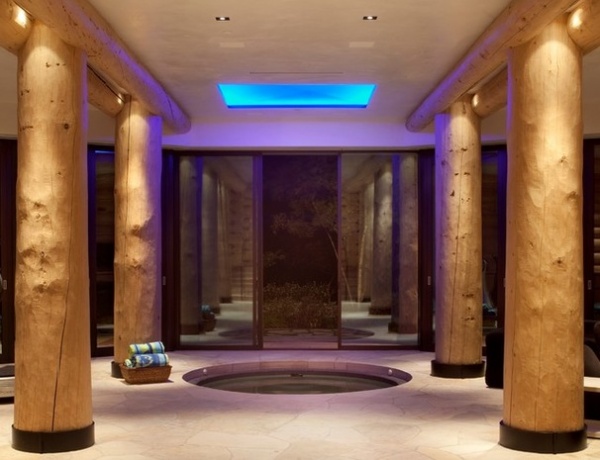
LEDs are often used to highlight special architectural features, and they are available in a myriad of colors. Here, Mackell used white and blue LED cove lights over the spa area, while recessed lights between the ceiling logs graze the surface of the log columns to accentuate their volume and texture.
Besides lightbulbs, there are light fixtures that have LED bulbs built into the housing for a single integrated unit. LEDs are suitable for cove lights, pendants, recessed fixtures and undercabinet accent lights.
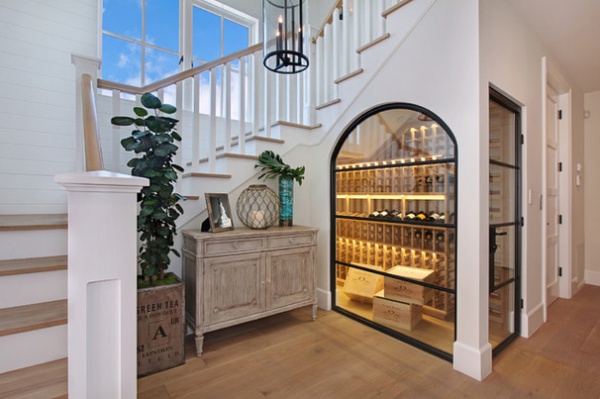
LEDs are appropriate for wine storage because they emit very little heat. Too much heat can cause a temperature imbalance and affect the quality of the wine. Before LEDs, this cellar would probably have been lit by damaging incandescents or unattractive fluorescents. Mackell cautions that fluorescents are also damaging, as they emit UV light, which is bad for wine.
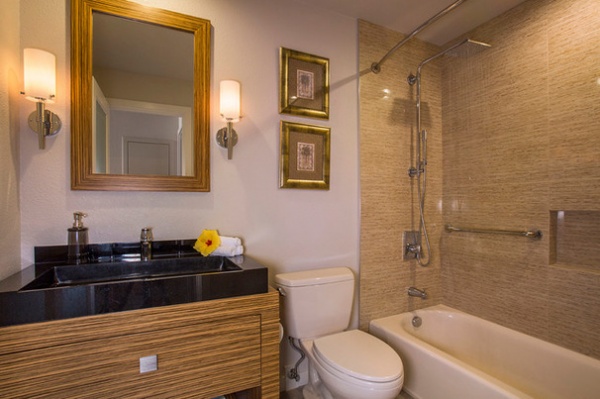
Dimmable LEDs
This bathroom is lit by dimmable overhead LED recessed lighting. If you want to use dimmable LEDs, be prepared to try different bulbs if you have an existing dimmer switch. Not every dimmable LED bulb works well with every dimmer switch. Problems that might arise are buzzing or an inability to be dimmed at low light levels. If you’re planning to install a new dimmer switch, check the bulb company’s website first for recommended dimmers for the particular bulb, so you can get an ideal combination.
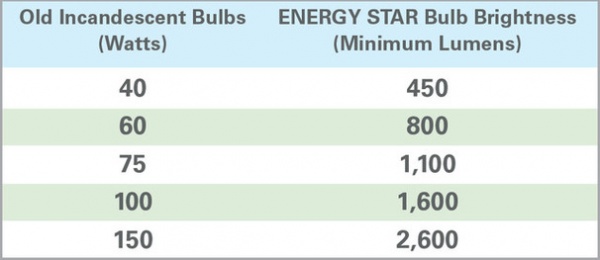
How to Buy LEDs
You may have noticed that LEDs don’t use a conventional wattage system. Instead, they advertise the amount of light given off, in lumens, versus the amount of energy required to produce the light. For example, a 75-watt incandescent needs a 1,100-lumen LED replacement to throw the comparable quantity of light. Here’s a handy chart showing the incandescent equivalents in LED.
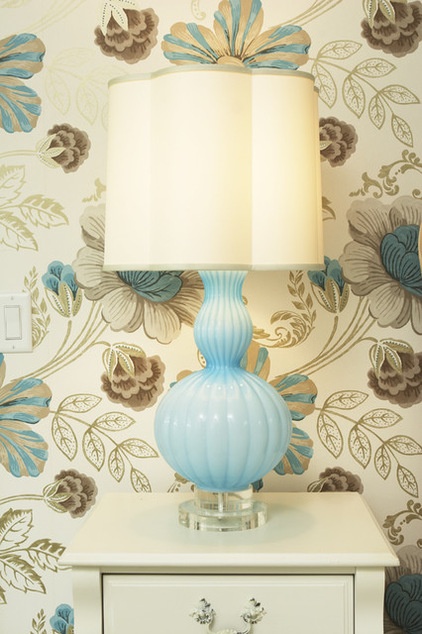
How Much Money Should You Expect to Save Switching to LEDs?
LED bulbs cost more than standard incandescent bulbs. Recently, however, prices for LEDs have been steadily decreasing. The most common Energy Star replacement bulbs (A19 and 60-watt replacements) can be found at the time of this writing for about $10 at most big-box retailers.
The EPA calculates the payback time of a 100-watt LED equivalent purchased at $38.12 (a 2013 price), used every day for three hours a day, to be three years, based on average U.S. utility rates. (Seeing as LED bulb costs have decreased, the payback is actually sooner.) Even better, a 60-watt equivalent purchased at $6 has a one-year payback period.
The ringer is that LEDs last a long time, an eternity in comparison to incandescents. LEDs don’t burn out or suddenly stop working like other types of bulbs. Instead, they decline. Otherwise known as “lumen depreciation,” the amount of light produced decreases and the color accuracy shifts. The LED’s lifetime is based on a prediction of when the light output will decrease by 30 percent. Jantz-Sell says that the current average life span of an Energy Star-certified LED bulb (or integrated fixture) is an astonishing 20 years with typical use.
Energy Star calculates that switching just one bulb from incandescent to Energy Star will reduce energy consumption between 70 to 90 percent and save $30 to $80 on utility bills over the lifetime of the bulb.
More:
5 Questions to Ask for the Best Room Lighting
Your Guide to Common Light Fixtures — and How to Use Them












